The Common Swift (Apus apus) is a marvel of avian evolution, known for its exceptional aerial abilities and unique lifestyle.
This remarkable bird species spends most of its life on the wing, rarely touching down except for nesting.
Found across Europe, Asia, and parts of Africa, Common Swifts undertake epic migrations, traveling thousands of kilometers between their breeding and wintering grounds.
They nest in colonies, often in urban areas, where their high-pitched calls and agile flight maneuvers captivate observers.
Despite facing conservation challenges, including habitat loss and urban development, Common Swifts inspires worldwide awe and fascination among bird enthusiasts.
Understanding the biology and behavior of these aerial acrobats offers insight into the intricacies of avian life and the importance of preserving their habitats for future generations. Stay sharp.
Physical Characteristics of Common Swift
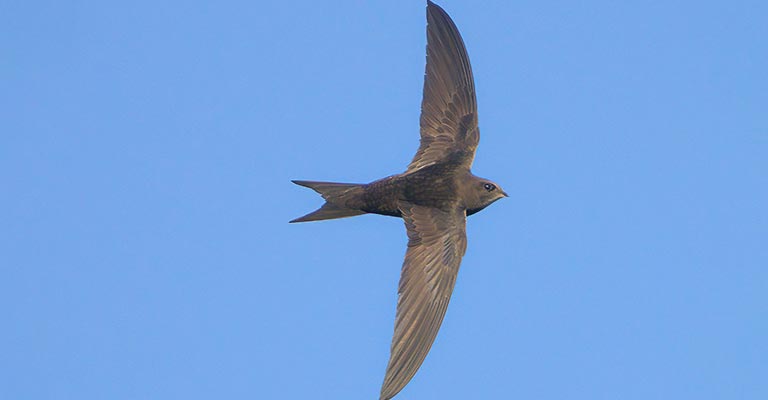
The Common Swift (Apus apus) is a fascinating bird known for its aerial prowess and distinctive physical characteristics.
Identifying these birds requires keen observation and an understanding of their unique features. Here are some of the key points to help you identify Common Swifts:
Sleek and Streamlined Body
Common Swifts have a slender, torpedo-shaped body adapted for swift flight.
Their bodies are designed to cut through the air with minimal resistance, enabling them to maneuver swiftly and effortlessly through the sky.
Uniformly Dark Plumage
One of the most distinctive features of Common Swifts is their uniformly dark plumage.
Their entire body, including the head, back, wings, and tail, is typically dark, dingy brown or black. This uniformity helps them blend seamlessly into the sky as they soar above.
Forked Tail
Common Swifts have a distinctive forked or “scythe-like” tail, which sets them apart from other similar-looking birds.
The deeply forked tail is a critical characteristic that aids in their aerodynamic performance, allowing for more excellent maneuverability during flight.
Long, Narrow Wings
Their wings are long and narrow, with a wingspan ranging from approximately 38 to 44 centimeters. These wings are well-suited for gliding and soaring over vast distances, making Common Swifts highly efficient flyers.
Small, Rounded Head
Common Swifts have a small, rounded head compared to their sleek body. Their heads appear almost triangular and lack distinct markings or patterns when viewed from certain angles.
Elongated Wings in Flight
When in flight, Common Swifts display a distinctive silhouette characterized by their elongated wings and forked tails. They often fly high in the sky in groups, performing intricate aerial maneuvers as they hunt for insects on the wing.
High-Pitched Scream
While not a physical characteristic, the high-pitched screaming calls of Common Swifts are often heard when they are flying overhead.
These vocalizations are used for communication among individuals and can help locate swifts even when they are not visible.
Urban Nester
Common Swifts are frequently found nesting in urban areas, particularly in old buildings and structures with suitable nesting sites, such as crevices and eaves.
During the breeding season, they can be observed darting in and out of these nesting sites as they care for their young.
Identifying Common Swifts involves recognizing their sleek, uniformly dark plumage, forked tail, long, narrow wings, small rounded heads, and distinctive flight patterns.
Their high-pitched calls and preference for urban nesting sites further aid their identification.
Taxonomy of Common Swift
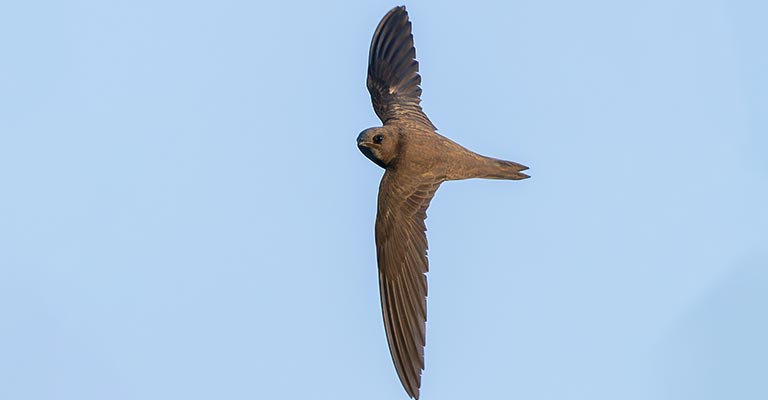
Here’s a quick table summarizing the taxonomy details of Common Swift based on the provided information:
| Taxonomic Level | Classification |
| Domain | Eukaryota |
| Kingdom | Animalia |
| Phylum | Chordata |
| Class | Aves |
| Clade | Strisores |
| Order | Apodiformes |
| Family | Apodidae |
| Genus | Apus |
| Species | A. apus |
The Central European subspecies of the Common Swift, known scientifically as Apus apus palapus, provides a fascinating glimpse into the evolutionary history of this remarkable bird species.
During the last ice age, Central Europe was characterized by harsh environmental conditions, including extensive glaciation and fluctuating temperatures.
Despite these challenges, the Common Swift adapted to the changing landscape. Apus apus palapus likely exhibited unique adaptations to survive Central Europe’s cold and variable climate during the ice age.
These adaptations may have included changes in plumage coloration, body size, and behavior to cope with the challenges posed by the glacial environment.
Studying subspecies such as Apus apus palapus can provide valuable insights into the genetic diversity and evolutionary processes shaping the Common Swift population.
By understanding how different populations have adapted to their respective environments over time, scientists can better understand the species’ resilience and ability to thrive in diverse habitats.
While Apus apus palapus may no longer exist today, its legacy lives on through its descendants, including the modern-day Common Swifts across Europe, Asia, and Africa.
Common Swift Life History
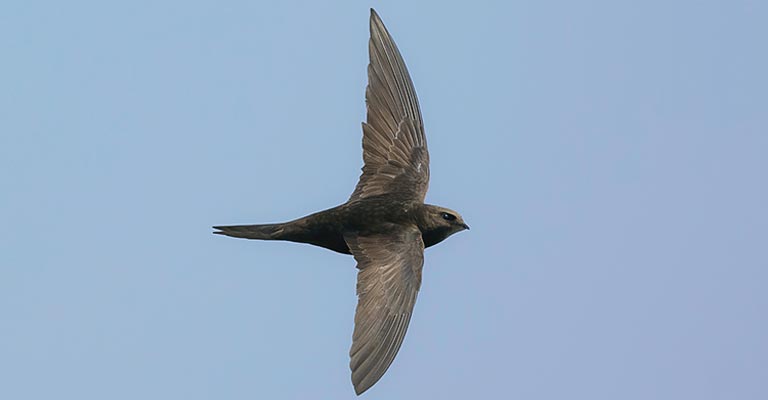
The Common Swift (Apus apus) is a remarkable bird renowned for its extraordinary aerial abilities and unique life history.
Found across Europe, Asia, and parts of Africa, these birds have adapted to a life spent almost entirely in flight.
Understanding the life history of the Common Swift provides insight into its fascinating behaviors and adaptations.
Food
Common Swifts are insectivorous birds, feeding exclusively on insects caught in flight. They have specialized adaptations such as a wide gap and bristles around their mouths to capture their prey while flying.
Their diet primarily consists of small flying insects, including flies, beetles, and ants, which they catch on the wing using their agile flight maneuvers.
Habitat
Common Swifts are highly adapted to an aerial lifestyle and are seldom seen on the ground except when nesting.
They are commonly found in urban and suburban areas, nesting in old buildings, church steeples, and other structures with suitable crevices and eaves for nesting sites.
During migration and winter, they inhabit many habitats, including open fields, forests, and coastal areas.
Range Map

Common Swifts have a vast breeding range across Europe and Asia, extending from the Mediterranean region to northern Scandinavia and Siberia.
During the non-breeding season, they migrate to sub-Saharan Africa, crossing vast distances to reach their wintering grounds.
Their migratory routes cover thousands of kilometers, with some individuals traveling as far as southern Africa.
Breeding
Breeding occurs during summer when Common Swifts return to their breeding grounds. They are colonial nesters, often nesting in large groups in urban areas.
Females lay a single clutch of 2-3 eggs in a nest constructed of feathers, plant material, and saliva, typically attached to the walls of buildings or in natural cavities.
Both parents share incubation duties and care for the young, which fledge after approximately 6-7 weeks.
Diseases and Treatment
Common Swifts may be susceptible to avian pox and parasitic infections. However, their aerial lifestyle and migratory behavior make them less prone to certain diseases than ground-dwelling birds.
In cases of injury or illness, rehabilitation centers may provide treatment and care for sick or injured swifts before releasing them back into the wild.
Conservation
While Common Swifts are listed as a species of “Least Concern” by the International Union for Conservation of Nature (IUCN), they face habitat loss, urban development, and climate change threats.
Conservation efforts focus on preserving nesting sites, raising awareness about the importance of swift-friendly architecture, and studying migration patterns to protect their wintering grounds better.
The life history of the Common Swift is characterized by its specialized adaptations for aerial life, including its diet, habitat preferences, and migratory behavior.
Understanding the various aspects of their life history is crucial for conserving these remarkable birds and ensuring their continued survival in the wild.
Nesting Habit of Common Swift
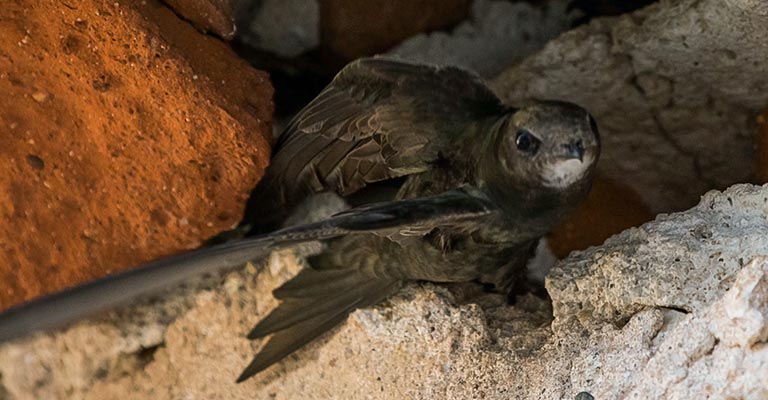
Here’s an excellent table detailing the nesting habits of the Common Swift:
| Nesting Detail | Description |
| Clutch Size | Typically 2-3 eggs per clutch |
| Number of Broods | Smooth and glossy, pure white |
| Egg Length | Approximately 2.3-2.5 centimeters (0.9-1.0 inches) |
| Egg Width | Approximately 1.5-1.7 centimeters (0.6-0.7 inches) |
| Incubation Period | Around 19-21 days |
| Nestling Period | Approximately 6-7 weeks |
| Egg Description | Smooth and glossy, pure white in color |
| Nest Construction | Constructed from feathers, plant material, and saliva |
| Nest Location | Attached to walls of buildings or in natural cavities |
| Parental Care | Both parents share incubation duties and care for young |
| Fledging | Young fledge after approximately 6-7 weeks |
| Nest Reuse | Swifts may reuse nests in subsequent breeding seasons |
This table provides an overview of the nesting habits of the Common Swift, including details about clutch size, egg dimensions, incubation and nestling periods, egg description, nest construction, parental care, fledging, and nest reuse.
Common Swifts are colonial nesters, often found in large groups nesting in urban areas. They construct their nests using feathers, plant material, and saliva, attaching them to the walls of buildings or in natural cavities.
Females typically lay 2-3 eggs per clutch, which are smooth, glossy, and pure white. Both parents share incubation duties, with an incubation period of around 19-21 days.
After hatching, the young remain in the nest for approximately 6-7 weeks before fledging. Common Swifts may reuse nests in subsequent breeding seasons, contributing to their colonial nesting habit and the abundance of nests in urban environments.
10 Fun Facts About Common Swift
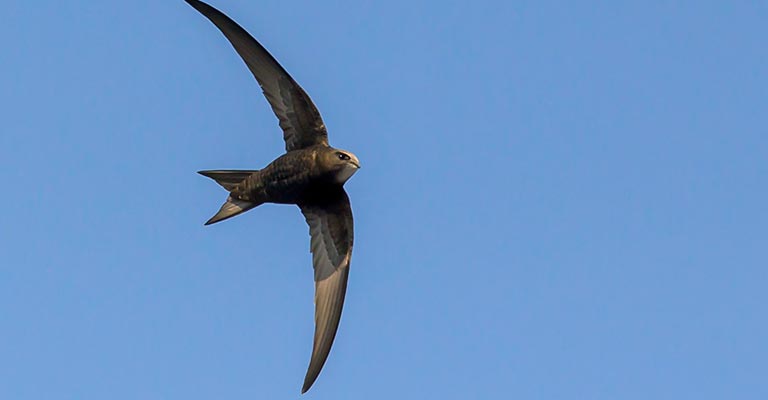
The Common Swift (Apus apus) is a remarkable bird known for its extraordinary aerial abilities and unique behaviors. Here are ten fascinating facts about these avian wonders:
- Aerial Acrobats: Common Swifts spend their entire lives in the air, even sleeping and mating on the wing. They are exceptionally skilled fliers, capable of intricate aerial maneuvers and reaching up to 111 kilometers per hour (69 mph).
- Non-Stop Migration: During their annual migration, Common Swifts travel thousands of kilometers between their breeding and wintering grounds in sub-Saharan Africa. Remarkably, they undertake this journey without stopping to rest or eat, relying solely on stored fat reserves for energy.
- Longevity in Flight: Common Swifts have been known to stay airborne for up to ten months during migration, only landing to breed and raise their young. This extended flight period sets them apart as one of the most aerially adept bird species.
- Colonial Nesters: Common Swifts nest in large colonies, often occupying urban areas and nesting in the eaves and crevices of buildings. These colonies can consist of hundreds or thousands of individuals, creating a bustling avian community.
- Specialized Feet: Unlike many other birds, Common Swifts have tiny, weak feet with reduced claws, which are ill-suited for perching. This adaptation reflects their aerial lifestyle, as they spend minimal time on the ground.
- High-Pitched Calls: Common Swifts are known for their distinctive screaming calls, which they use for communication and navigation during flight. These calls can often echo through the skies as swifts soar overhead.
- Swift Courtship Rituals: During the breeding season, male Common Swifts perform elaborate aerial displays to attract females. These displays involve steep dives, rapid ascents, and synchronized flights, showcasing the males’ agility and prowess.
- Feeding on the Wing: Common Swifts are skilled insectivores, catching their prey while flying at high speeds. They use their wide gape and specialized bristles around their mouths to capture flying insects such as flies, beetles, and ants.
- Extreme Nesting Heights: Common Swifts are known to nest at dizzying heights, with colonies sometimes located several stories above the ground. This preference for high nesting sites provides them with protection from ground-based predators.
- Conservation Concerns: Despite their remarkable adaptations, Common Swifts face conservation challenges such as habitat loss, urban development, and climate change. Conservation efforts are crucial to safeguarding their nesting sites and migratory routes for future generations to enjoy these aerial marvels.
Wrapping Up
So, the Common Swift is a captivating bird species renowned for its aerial prowess, unique behaviors, and remarkable adaptations.
From their non-stop migration to their colonial nesting habits and specialized aerial feeding techniques, Common Swifts exemplify the wonders of avian life.
However, they also face conservation challenges that underscore the importance of protecting their habitats and migratory routes.
By raising awareness and implementing conservation measures, we can ensure the continued survival of these fascinating birds for generations to come. Thank you so much.